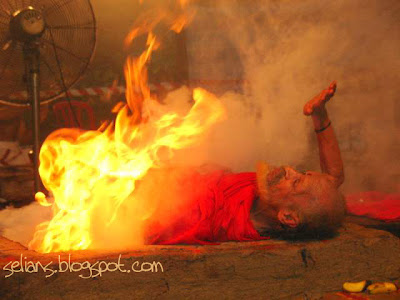Muktinath
Muktinath, a sacred place both for Hindus as well as Buddhists, is located at an altitude of 3,710 meters at the foot of the Thorong La mountain pass (part of the Himalayas) , Mustang district, Kingdom of Nepal. The Hindus call the place Mukti Kshetra, which literally means the "place of salvation", while the Buddhists call it Chumig Gyatsa, which in Tibetan means 'Hundred Waters'. For Tibetan Buddhists Muktinath-Chumig Gyatsa is a place of Dakinis, goddesses known as Sky Dancers. It is of great importance for Buddhists that Chumig Gyatsa is one of the 24 Tantric places.
The temple
The shrine of Muktinath is considered one of the eight most sacred shrines for Hindu Vashanavites known as Svayam Vyakta Ksetras, the other seven being Srirangam, Sri Mushnam, Tirupati, Naimisaranyam, Thottadri, Pushkaram and Badrinath. The temple is very small. Muktinath is one of the most ancient Hindu temples of God Vishnu. Many people also claim the shrine to be a Buddhist shrine. The idol is of gold and is tall enough to compare with a man. The prakaram has 108 bull faces through which water is poured. It is freezing temperature. There is an Old Buddhist monk present in the temple.
Legend
The Tibetan Buddhist tradition states that for this reason Guru Rinpoche, also known as Padmasambhava, the founder of Tibetan Buddhism had meditated at Muktinath on his way to Tibet. It is one of the 51 Sakthi peetams.
Sri Murthy Mahatyam
In this astonishing journey there lies the only place on earth where you can find all five tatvas, the five elements from which everything is made, according to the Hindu tradition: fire, water, sky, earth and air at the same place together in their own and distinct form. This place is near Jwala Devi temple.
The entire river bed has Salagrama stones which is equivalent in worshipping Lord Vishnu.
According to Sri Vaishnava philosophy, it is considered to be one of the Divya desam (108 in total) or holy places of worship of Lord Vishnu, where the Alwars or Viashnavite Saints had sung in praise of the Lord, which is compiled as the Nalayira Divya Prabandha.
One has to be gifted to get the Darshan of Lord Sri Murthi and Goddess Sri Devi Thayaar.
Prasadam
There is no specific priest to maintain the temple. Pilgrims who go there should offer food to Lord.
Darshan, sevas and festivals
The most suitable time time to visit Muktinath is from March to June, as the weather conditions would not be safe enough to travel in other months. In your journey you will come across many archeological sites and temples, and will see and feel the enchanting Himalayas.
Composers
Thirumangai Alvar could not reach Muktinath, but had sung from nearest place in praise of Lord SriMurthy. Periyalvar had sung in praise of Sri Murthi as "Salagramamudaiya Nambi".
Travel access
It is quite difficult to travel because of tough weather conditions. From Delhi to Katmandu flight and then from Katmandu to Jomsom Airport. From there, trekking can be done or through private helicopter. The helicopter would take around 45 minutes to reach and then it would leave there for 1 hr and then the return trip is taken. The helicopter can be hired only when the weather permits.
Source: http://en.wikipedia.org/wiki/Muktinath
The temple
The shrine of Muktinath is considered one of the eight most sacred shrines for Hindu Vashanavites known as Svayam Vyakta Ksetras, the other seven being Srirangam, Sri Mushnam, Tirupati, Naimisaranyam, Thottadri, Pushkaram and Badrinath. The temple is very small. Muktinath is one of the most ancient Hindu temples of God Vishnu. Many people also claim the shrine to be a Buddhist shrine. The idol is of gold and is tall enough to compare with a man. The prakaram has 108 bull faces through which water is poured. It is freezing temperature. There is an Old Buddhist monk present in the temple.
Legend
The Tibetan Buddhist tradition states that for this reason Guru Rinpoche, also known as Padmasambhava, the founder of Tibetan Buddhism had meditated at Muktinath on his way to Tibet. It is one of the 51 Sakthi peetams.
Sri Murthy Mahatyam
In this astonishing journey there lies the only place on earth where you can find all five tatvas, the five elements from which everything is made, according to the Hindu tradition: fire, water, sky, earth and air at the same place together in their own and distinct form. This place is near Jwala Devi temple.
The entire river bed has Salagrama stones which is equivalent in worshipping Lord Vishnu.
According to Sri Vaishnava philosophy, it is considered to be one of the Divya desam (108 in total) or holy places of worship of Lord Vishnu, where the Alwars or Viashnavite Saints had sung in praise of the Lord, which is compiled as the Nalayira Divya Prabandha.
One has to be gifted to get the Darshan of Lord Sri Murthi and Goddess Sri Devi Thayaar.
Prasadam
There is no specific priest to maintain the temple. Pilgrims who go there should offer food to Lord.
Darshan, sevas and festivals
The most suitable time time to visit Muktinath is from March to June, as the weather conditions would not be safe enough to travel in other months. In your journey you will come across many archeological sites and temples, and will see and feel the enchanting Himalayas.
Composers
Thirumangai Alvar could not reach Muktinath, but had sung from nearest place in praise of Lord SriMurthy. Periyalvar had sung in praise of Sri Murthi as "Salagramamudaiya Nambi".
Travel access
It is quite difficult to travel because of tough weather conditions. From Delhi to Katmandu flight and then from Katmandu to Jomsom Airport. From there, trekking can be done or through private helicopter. The helicopter would take around 45 minutes to reach and then it would leave there for 1 hr and then the return trip is taken. The helicopter can be hired only when the weather permits.
Source: http://en.wikipedia.org/wiki/Muktinath


Comments